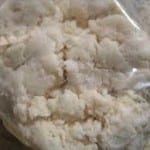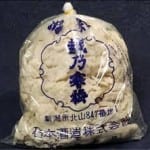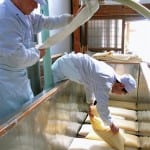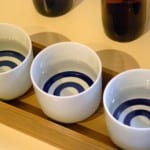 Should you frequent sake retailers with anything resembling a good selection of sake, you will often find for sale bags of sake kasu: beige chunks and chips of something resembling cheese or tofu. Sometimes, the unmistakable fragrance of sake wafts up from the clear plastic bag as it sits on the counter.
Should you frequent sake retailers with anything resembling a good selection of sake, you will often find for sale bags of sake kasu: beige chunks and chips of something resembling cheese or tofu. Sometimes, the unmistakable fragrance of sake wafts up from the clear plastic bag as it sits on the counter.
What is sake kasu? In short, sake lees. What the heck are lees? In short, dregs. What the heck are they dregs of? In short, the brewing process.
After a tank of the white fermenting mash called moromi has run its course– anywhere from 18 to 32 days –what remains is a white mixture of sake and the solids that did not or could not be fermented. This must now be pressed to separate the slightly amber sake from these suspended solids.
There are several methods of pressing, but all accomplish the same thing: the fermenting mash is filtered, and the sake is squeezed out, leaving a compressed form of the solids, or lees, behind. This caked stuff is kasu.
When sake is pressed by machine, the kasu comes out in nice, tightly pressed, square pancakes. Usually this kasu is drier, having been manhandled by  the high pressure of the pressing machine. Sake pressed in the older methods, using a big wooden box called a fune, in which the lid gets cranked down on moromi that has been poured to small canvas bags laid neatly inside the fune, will yield sake kasu that is more chunky, broken up, and formless.
the high pressure of the pressing machine. Sake pressed in the older methods, using a big wooden box called a fune, in which the lid gets cranked down on moromi that has been poured to small canvas bags laid neatly inside the fune, will yield sake kasu that is more chunky, broken up, and formless.
Also, some sake is pressed with more pressure applied to the moromi than other sake. Sometimes the brewers want every last drop, at the expense of flavor, and other times sake is treated more gently, to maintain fine lines and subtle facets. The difference is quite noticeable in the sake. It is also apparent in the firmness of the kasu. In fact, a sake brewer will always inspect the kasu, since so much about how the fermentation proceeded is revealed in it. How the starch in the dissolved – or did not dissolve – is one piece of critical information a brewer can derive from the kasu.
 Certainly sake kasu is easier to find in the winter, but these days, sake retailers in Japan and Japanese groceries the world-round carry kasu for consumers. In fact, brewers can barely keep it from flying out the door. Sake kasu has long been used in Japanese cuisine, and imparts a unique flavor and touch. It is commonly used in miso soup (often with salmon or pork as well), and is also outstanding as a marinade for grilled fish.
Certainly sake kasu is easier to find in the winter, but these days, sake retailers in Japan and Japanese groceries the world-round carry kasu for consumers. In fact, brewers can barely keep it from flying out the door. Sake kasu has long been used in Japanese cuisine, and imparts a unique flavor and touch. It is commonly used in miso soup (often with salmon or pork as well), and is also outstanding as a marinade for grilled fish.
Not all sake kasu in the industry is used for cooking, by the way. Some is used as livestock feed, and some is actually recycled and distilled to make something called kasu-dori shochu, or shochu made from kasu.
Sake kasu is relatively rich in protein, with 100 grams having as much as 70 grams of beef, as well as being full of vitamins B1, B2 and B6. Also, the carbohydrate content too is fairly high. Not bad for the dregs of the sake brewing process.
~~~~~~~~~~~~~~~~~~~~
Sake Professional Course in Florida, August 17-19
 Thanks to everyone’s support and the current popularity of sake, the Sake Professional Course in Las Vegas, June 1-3, is full. The next Sake Professional Course is scheduled for Miami Beach Florida, August 17-19, at the Shelborne Wyndham Grand Hotel, within which sits the South Beach Morimoto Restaurant. This is the first Sake Professional Course to be held in this part of the country and promises to be a particularly enjoyable running of the course.
Thanks to everyone’s support and the current popularity of sake, the Sake Professional Course in Las Vegas, June 1-3, is full. The next Sake Professional Course is scheduled for Miami Beach Florida, August 17-19, at the Shelborne Wyndham Grand Hotel, within which sits the South Beach Morimoto Restaurant. This is the first Sake Professional Course to be held in this part of the country and promises to be a particularly enjoyable running of the course.
More information is available here, and testimonials from graduates can be perused here as well. The three-day course wraps  up with Sake Education Council supported testing for the Certified Sake Professional (CSP) certification. If you are interested in making a reservation, or if you have any questions not answered via the link above, by all means please feel free to contact me.
up with Sake Education Council supported testing for the Certified Sake Professional (CSP) certification. If you are interested in making a reservation, or if you have any questions not answered via the link above, by all means please feel free to contact me.
Following that, the next one is tentatively scheduled for the fall in the northeast part of the US. If you are interested, feel free to send me an email to that purport now; I will keep track of your interest!




